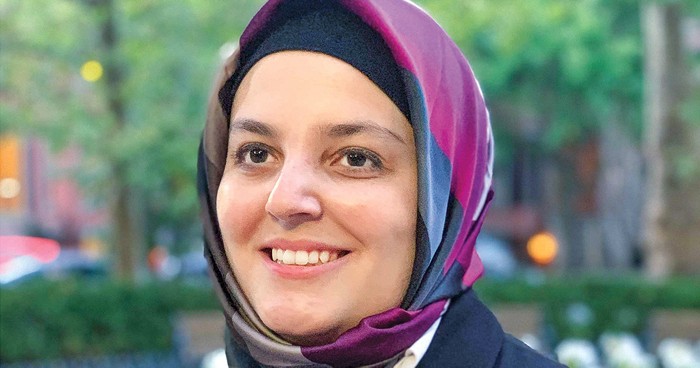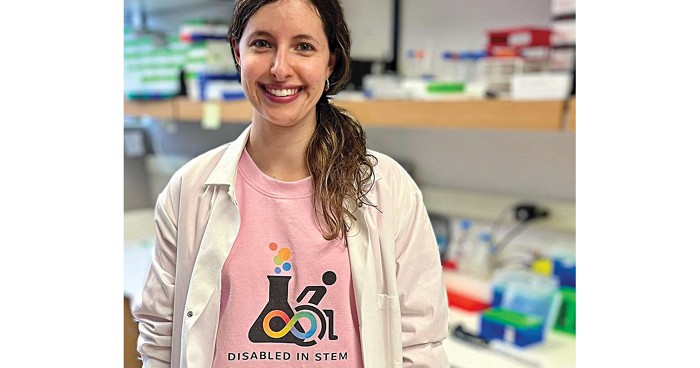Advertisement
Grab your lab coat. Let's get started
Welcome!
Welcome!
Create an account below to get 6 C&EN articles per month, receive newsletters and more - all free.
It seems this is your first time logging in online. Please enter the following information to continue.
As an ACS member you automatically get access to this site. All we need is few more details to create your reading experience.
Not you? Sign in with a different account.
Not you? Sign in with a different account.
ERROR 1
ERROR 1
ERROR 2
ERROR 2
ERROR 2
ERROR 2
ERROR 2
Password and Confirm password must match.
If you have an ACS member number, please enter it here so we can link this account to your membership. (optional)
ERROR 2
ACS values your privacy. By submitting your information, you are gaining access to C&EN and subscribing to our weekly newsletter. We use the information you provide to make your reading experience better, and we will never sell your data to third party members.
Diversity
New Survey On Minority Chemistry Professors Released
Percentage of underrepresented minorities in faculty positions remains stuck at 4%
by Linda Wang , Sophie L. Rovner
May 18, 2015
| A version of this story appeared in
Volume 93, Issue 20
Nearly one-third of the U.S. population is made up of underrepresented minorities, according to U.S. Census Bureau figures. Yet they hold only 4% of chemistry professorships at the 50 U.S. colleges and universities that spend the most on chemical research and development.
These data on the number of minority professors at the leading Ph.D.-granting chemistry departments in the U.S. come from a new survey by the Open Chemistry Collaborative in Diversity Equity, a five-year program cofunded by the National Science Foundation, the National Institutes of Health, and the Department of Energy. Known as OXIDE, this group works with research-intensive chemistry departments to broaden faculty diversity. It conducted a survey about the racial and ethnic makeup of faculty in these departments.
That 4% figure is “discouraging, but it’s not surprising,” says Malika Jeffries-EL, an associate professor of chemistry at Iowa State University. We can’t keep doing the same things and expect the statistics to improve, she says. “You have to be very intentional in your recruitment” to attract minority applicants.

Luis Echegoyen, a professor of chemistry at the University of Texas, El Paso, notes the percentage of underrepresented minorities (URMs) in chemistry faculty positions hasn’t improved much since he was a program officer in the Chemical Dynamics Program at NSF in the early 1980s. “After all the federal funding that has been put into increasing the number of URMs in faculty positions, the truth is that 30 years later, we have very little to show for it,” he says.
URM = Underrepresented minorities, includes African American, Hispanic/Latino/Latina, Native American, and multiracial. SOURCE: OXIDE survey

URM = Underrepresented minorities, includes African American, Hispanic/Latino/Latina, Native American, and multiracial. SOURCE: OXIDE survey
“Our country is changing, and the demographics of the population are changing, yet we aren’t seeing the demographics change in terms of the chemistry faculty,” says Charles D. Pibel, a chemistry program director at NSF. “The fact that things haven’t changed isn’t so much an excuse to give up, but to try something else.” Pibel notes that chemists play an important role in solving global challenges, and “it behooves us to make sure that we’ve got the best people working on these problems.”
Rigoberto Hernandez, director of OXIDE and a professor of chemistry at Georgia Institute of Technology, says he hopes the OXIDE initiative will help foster a more supportive environment for URMs and other diversity groups in academia. According to Hernandez, OXIDE hypothesizes that URMs are not as attracted to academic positions as their peers because of “real and perceived inequities” within chemistry departments, such as research advisers who show favoritism toward one racial group over another. “My hope,” he says, “is that, in partnership with the chairs of chemistry departments, OXIDE’s activities will help change the climate and draw more URMs to the academy to achieve equitable demographic representation.”

OXIDE collected ethnic and racial data from universities that NSF says spent the most on chemical research in each of the past three academic years. The OXIDE survey covered tenured and tenure-track positions for which a chemistry department paid at least half of the salary. The group gathered statistics about Asians and Pacific Islanders; white non-Hispanics; and URMs, a category that in this context comprises African American, Hispanic/Latino/Latina, Native American, and multiracial professors. They are considered URMs because their representation on chemistry faculties is lower than in the general U.S. population.
Of the 50 schools that spent the most on chemical R&D in fiscal 2013 (referred to as “top 50” here, although it should be noted this ranking is not based on the quality of research conducted or education offered), two did not provide OXIDE data about the race or ethnicity of their faculty for the 2013–14 academic year; they have been excluded from the statistics discussed in this story. However, any data they did provide, such as total faculty numbers or statistics for prior years, are included in the tables accompanying this story in print and online.
Among the schools surveyed by OXIDE, Georgia Tech (16%) and the University of California, San Diego (11%), had the greatest number of chemistry professorships held by URMs that year. These were the only top 50 schools in which URMs held more than 10% of professorships during the 2013–14 academic year. Meanwhile, 11 of the reporting schools had no URM chemistry professors.
OXIDE found some degree of variability between ranks when it broke down its top 50 numbers: URMs held some 5% of assistant professor positions at these schools, 7% of associate professorships, and 4% of full professorships.

Overall, the top 50 schools that provided OXIDE with URM data for 2013–14 employed 1,605 chemistry faculty, including 1% African American, 3% Hispanic/Latino/Latina, less than 1% Native American, and less than 1% multiracial professors. Some 13% of the chemistry faculty were Asians or Pacific Islanders, and 82% were white non-Hispanic.
OXIDE’s survey also included the 2012–13 and 2011–12 academic years. It revealed that the percentage of URMs in faculty positions has changed little, at least over the past three years. One possible explanation may be the weak job market. “After the economic recession hit in 2008 to 2009, some universities stopped hiring new faculty completely,” says Robert J. Stack, a program manager in the Office of Basic Energy Sciences at DOE. “How do you impact the numbers of underrepresented minorities when there are so few open positions to fill?”
“Right now is almost the worst time to become a faculty member, and NSF is funding research grants at the lowest rate that I’ve ever seen in my lifetime,” says Susan M. Kauzlarich, chair of the chemistry department at the University of California, Davis. “If I were young again, the idea of going into academics would be pretty daunting. But how do we change that? We have to change the system to make this a more attractive career.”
There are bright spots, however. Judy Kim, a chemistry professor at UC San Diego, says faculty hiring is starting to pick up again. And searches are now more open than when she first arrived 10 years ago. For example, in the university’s “Excellence Searches” program, candidates with a strong commitment to diversity and who show excellence in their scholarly achievements are considered for faculty positions even if an opening is not officially available. These searches have created more opportunities for candidates, including URMs, that enhance diversity on campus.
Echegoyen says he’s encouraged by the changing attitudes he’s seen among chemistry department chairs, thanks to efforts such as OXIDE’s National Diversity Equity Workshop, which brings chemistry department chairs together every two years to discuss diversity. In 2008, when Echegoyen was an NSF division director trying to push chemistry department chairs at universities to take diversity more seriously, there was a lot of pushback, he says. “Now, the chairs are engaged, they are suggesting ideas, and they are taking an active role,” he adds. “I think they are finally embracing the concept.”

At Indiana University, for example, chemistry chair David Giedroc established a Diversity Affairs Committee within the chemistry department after getting the idea to do so at the 2013 National Diversity Equity Workshop. Members of the committee are expected to serve on recruiting and hiring committees, graduate admissions committees, and other committees that make decisions that affect the faculty and student body. “It helps to continue to shine light on the issues associated with a diverse faculty, a diverse graduate student body, and a diverse undergraduate body,” Giedroc says.
“We’re looking at the small victories,” says Dontarie Stallings, OXIDE research and program manager. “If you collectively have small victories, over time you’ll get to the right place.”
Mentorship can also help foster an inclusive environment for URMs, says Gregory H. Robinson, a professor of chemistry at the University of Georgia. And mentorship can come from anyone. “I did not study chemistry because an African American chemistry professor suddenly encouraged me to do so,” he says. “The professors that reached out to me decades ago with encouragement were white male professors.”
Davita Watkins, who is in her first year of a tenure-track chemistry faculty position at the University of Mississippi, says being the only African American woman in her department comes with a lot of responsibility. “It makes me feel like I need to work hard, not just for myself, but for my female students,” she says. “It makes me work harder for them because I know I need to stay, and I need to do well.”
Go to http://cenm.ag/urmoxide for more data on the number of professors in each racial or ethnic group at the top 50 schools surveyed. And view more data from OXIDE at oxide.gatech.edu/urm2015.




Join the conversation
Contact the reporter
Submit a Letter to the Editor for publication
Engage with us on Twitter